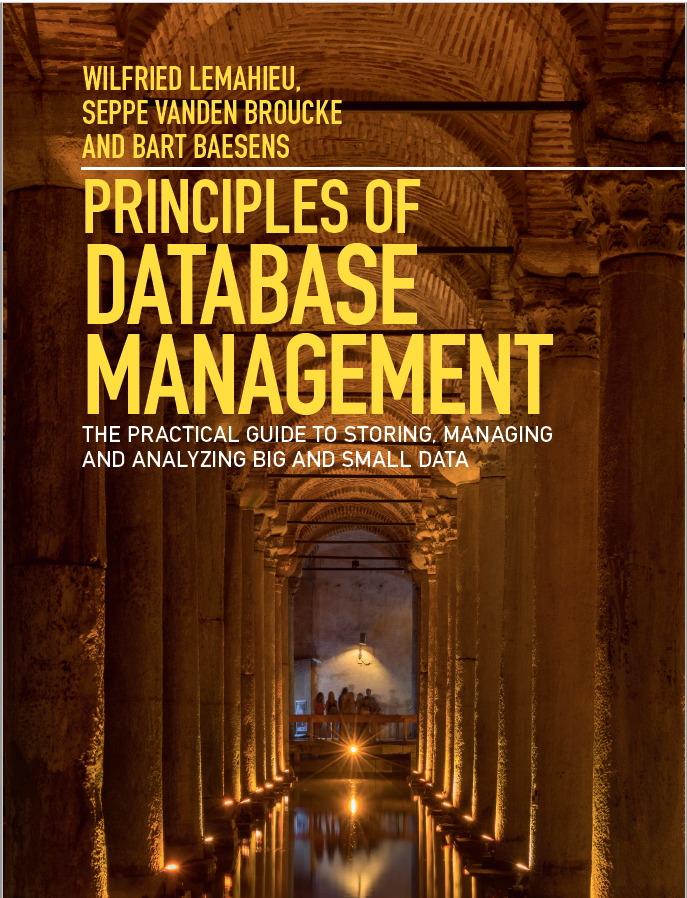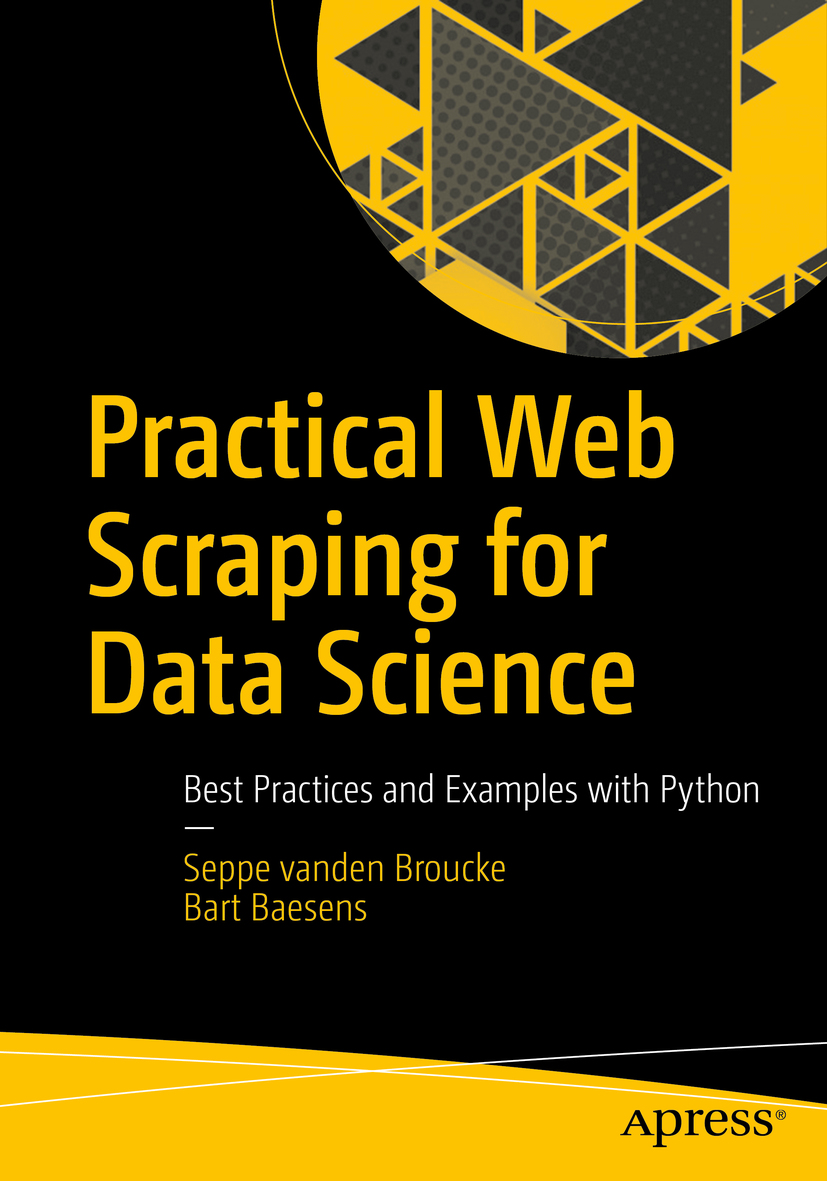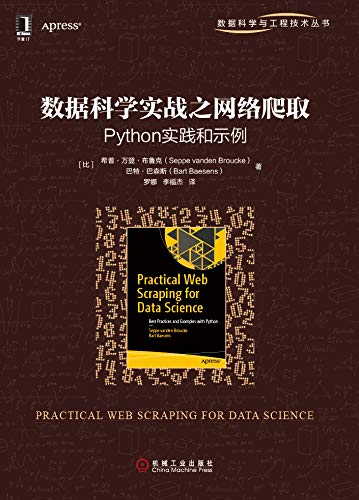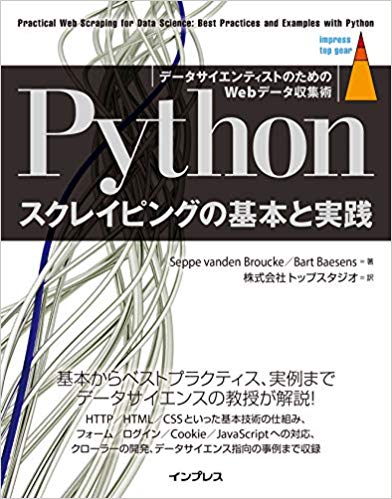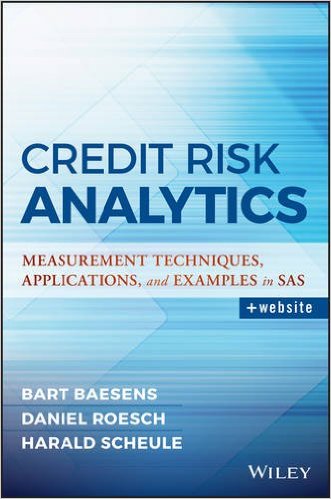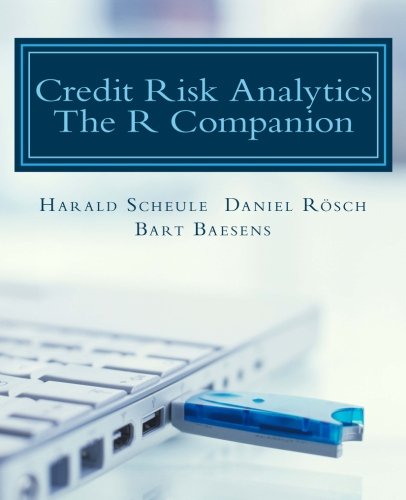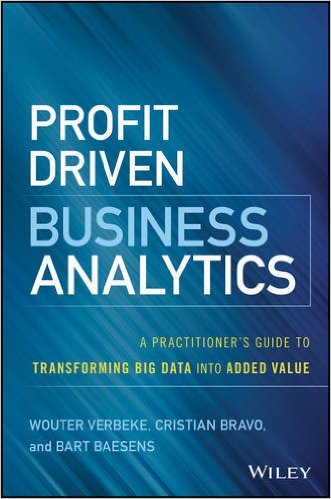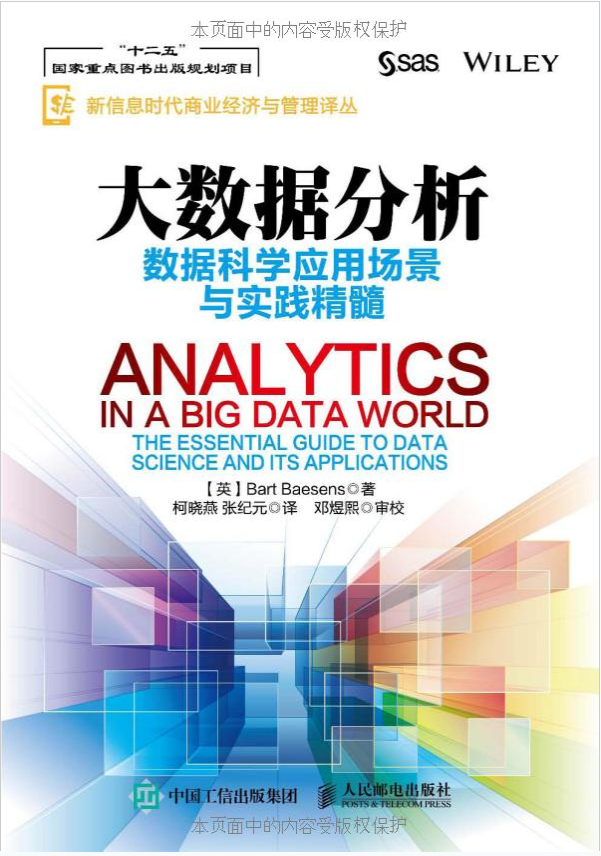Books
Customer Lifetime Value Modeling with Applications in Python and R
Buy the book here: Amazon, Amazon.fr, Amazon.co.uk, Amazon.de, Amazon.es, Amazon.it, Amazon.co.jp, Amazon.ca, Amazon.com.au
Get up to speed on measuring and modeling Customer Lifetime Value!Managing Customer Lifetime Value provides marketeers, data science practitioners, business professionals and analytics managers with a comprehensive guide to understand, model, analyze, manage and deploy Customer Lifetime Value!
Providing state of the art industry and research insights based on the author’s extensive experience, this illustrated textbook has a well-balanced theory-practice focus and covers all essential topics.
More information: www.clvbook.com
Managing Model Risk
Buy the book on Amazon.com, .co.uk, .fr, .de, .es, .it, .co.jp, .ca, .com.au.
Get up to speed on identifying and tackling model risk!Managing Model Risk provides data science practitioners, business professionals and analytics managers with a comprehensive guide to understand and tackle the fundamental concept of analytical model risk in terms of data, model specification, model development, model validation, model operationalization, model security and model management.
Providing state of the art industry and research insights based on the author’s extensive experience, this illustrated textbook has a well-balanced theory-practice focus and covers all essential topics.
Key Features: Extensive coverage of important trending topics and their risk impact on analytical models, starting from the raw data up until the operationalization, security and management. Various examples and case studies to highlight the topics discussed. Key references to background literature for further clarification. An online website with various add-ons and recent developments: www.managingmodelriskbook.com. What Makes this Book Different?This book is based on both authors having worked in analytics for more than 30 years combined, both in industry and academia. Both authors have co-authored more than 300 scientific publications on analytics and machine learning and have worked with firms in different industries, including (online) retailers, financial institutions, manufacturing firms, insurance providers, governments, etc. all over the globe estimating, deploying and validating analytical models.
Throughout this time, we have read many books about analytical modeling and data science, which are typically written from the perspective of a theorist, providing lots of details with regards to different model algorithms and related mathematics, but with limited attention being given to how such models are used in practice. If such concerns are tackled, it is mainly from an implementation, use case or data engineering perspective. From our own experience, however, we have encountered many cases where analytics, AI, machine learning etc. fail in organizations, even with skilled people working on them, due to a myriad of reasons: bad data quality, difficulties in terms of model deployment, lack of model buy-in, incorrect definitions of underlying goals, wrong evaluation metrics, unrealistic expectations and many other issues can arise which cause models to fail in practice.
Most of these issues have nothing to do with the actual algorithm being used to construct the model, but rather with everything else surrounding it: data, governance, maintenance, business, management, the economy, budgeting, culture etc. As such, we wanted to offer a new perspective with this book: it aims to provide a unique mix of both practical and research-based insights and report on do's and don'ts for model risk management. Model risk issues are not only highlighted but also recommendations are given on how to deal with them, where possible.
Table of Contents Preface About this Book What Makes this Book Different? Who this Book is For About the Authors Structure of the Book Chapter 1. Introduction to Model Risk What is Model Risk? Types and Sources of Model Risk Motivating Examples Chapter 2. Data Modeling Recap What’s In a Name? Let the Data Speak Types of Data Types of Learning Model Purpose Key Criteria of Predictive Models Model Development Processes Chapter 3. Data Risk Data Bias Data Bias and Ethics Data Perimeter Data Quality Lack of Predictive Power External Data Dependencies Data Regulation Concerns Lack of Data Human Labeling as a Solution? Incomplete or Noisy Labels Chapter 4. Specification Risk Incorrect Target Definition Uplift Modeling Improved Loss Functions Multicollinearity Buggy Digital Twins Chapter 5. Development Risk The Domain Knowledge Paradox The Citizen Data Scientist Risk Data Leakage Technological Myopia Programming Errors Assumptions Model Isolation Documentation On Deadlines and Agile Losing the End Users Fail Fast Vendor Lock-in Open Source Versus Commercial Software Chapter 6. Validation Risk Test Set Torturing Incorrect Cross-validation Generalization and Overfitting Unexpected Signs Wrong Evaluation Metrics Disagreeing Evaluation Metrics Wrong Usage of Continuous Retraining Interpreting Interpretability Techniques Complex Uninterpretable Models Still Make Sense Unsupervised Models Need Validation Too Model Benchmarking Calibration Model Auditing Chapter 7. Operational Risk Why Models Need to be Monitored Data Drift Output Drift Target and Performance Drift Usage Drift Technical Failures Model Overrides Model Retirement Chapter 8. Security Risk Model Outsmarting Model Backdooring Model Exfiltration Denial of Prediction (DOP) Attacks Chapter 9. Managerial Risk Transition Risk Model Governance Waste of Analytics Regulation Risk Wrong Model Usage Model Ethics Model Anxiety Climate Change and Ecological Risk Automated Machine Learning Time for a Chief Model Risk Officer? Chapter 10. Conclusions AudienceThis book is targeted towards everyone who has previously been exposed to both predictive and descriptive analytics. The reader should hence have some basic understanding of the analytics process model, the key activities of data preprocessing, the steps involved in developing a predictive analytics model (using e.g. linear or logistic regression, decision trees, etc.) and a descriptive analytics model (using e.g. association or sequence rules or clustering techniques). It is also important to be aware of how an analytical model can be properly evaluated, both in terms of accuracy and interpretation.
This book aims to offer a comprehensive guide for both data scientists as well as (C-level) executives and data science or engineering leads, decision-makers and managers who want to know the key underlying concepts of analytical model risk.
We hope you enjoy reading through this book as much as we enjoyed writing it.
Principles of Database Management
Authors: Wilfried Lemahieu, Bart Baesens, Seppe vanden Broucke
Publisher: Cambridge University Press
Get it on: Amazon
This book covers the principles of database management. It starts by defining databases and the various steps of database design. A next part zooms into different types of database systems: pre-relational, relational, object oriented, XML and no-SQL databases. Subsequent chapters discuss transaction management and physical data storage aspects. Also data access and data integration in an x-tier environment are extensively covered. The book concludes by discussing data warehousing, big data and analytics. Throughout the book, we will include various examples and case studies to illustrate and clarify the concepts discussed. Every chapter will conclude with a set of self-study questions such that the book can be easily used as a textbook by colleague instructors. We will also extensively report on both our research and industry experience on the topic to further illustrate the practical impact of the concepts discussed.
→ Read more information over at www.pdbmbook.com!
→ Access YouTube courses.
数据库管理:大数据与小数据的存储、管理及分析实战
Authors: Wilfried Lemahieu, Bart Baesens, Seppe vanden Broucke
Publisher: China Machine Press
Get it on: DangDang, JD
→ Read more information over at www.pdbmbook.com!
Practical Web Scraping for Data Science
Authors: Seppe vanden Broucke, Bart Baesens
Publisher: Apress
Get it on: Amazon
Get Started with Web Scraping using Python!
Congratulations! By picking up this book, you've set the first steps into the exciting world of web scraping. For those who are not familiar with programming or the deeper workings of the web, web scraping often looks like a black art: the ability to write a program that sets off on its own to explore the Internet and collect data is seen as a magical and exciting ability to possess. In this book, we set out to provide a concise and modern guide to web scraping, using Python as our programming language, without glossing over important details or best practices. In addition, this book is written with a data science audience in mind. We're data scientists ourselves, and have very often found web scraping to be a powerful tool to have in your arsenal, as many data science projects start with the first step of obtaining an appropriate data set, so why not utilize the treasure trove of information the web provides.
→ Read more information and get example source code over at www.webscrapingfordatascience.com!
数据科学实战之网络爬取:Python实践和示例
Authors: Seppe vanden Broucke, Bart Baesens
Publisher: Apress
Get it on: Amazon
本书提供了一个完整的、现代的Web抓取指南,使用Python作为编程语言,专为数据科学的读者编写,探讨了Web抓取和以及其背后的大量Web技术。书中首先简要概述抓取和现实生活中的用例,解释了HTTP、HTML和CSS的核心概念作为基础。最后总结了一些最佳实践和一系列的例子,这些数据科学用例汇集了你学到的所有知识。读者将学习到如何利用已建立的最佳实践和常用的Python包,处理包括JavaScript、Cookie和常见的web抓取技术。
Pythonスクレイピングの基本と実践
Authors: Seppe vanden Broucke, Bart Baesens
Publisher: Apress
Get it on: Amazon
スクレイピング・テクニックの基礎と実践を学べる。Webからデータを収集し、適切なデータセットを作成しよう! 本書では、HTTP/HTML/CSSといった基本技術の仕組み、フォーム/ログイン/Cookie/JavaScriptへの対応を解説。クローラーの開発、ベストプラクティス、データサイエンス指向の15のサンプルも収録。Pythonの各種ライブラリを活用!
Credit Risk Analytics
Authors: Bart Baesens, Daniel Roesch, Harald Scheule
Publisher: Wiley and SAS Business Series
Get it on: Amazon
ISBN-13: 978-1119143987 | ISBN-10: 1119143985
The long-awaited, comprehensive guide to practical credit risk modeling
Credit Risk Analytics provides a targeted training guide for risk managers looking to efficiently build or validate in-house models for credit risk management. Combining theory with practice, this book walks you through the fundamentals of credit risk management and shows you how to implement these concepts using the SAS credit risk management program, with helpful code provided.
→ Obtain the data sets used in the book here.
Fraud Analytics
Authors: Bart Baesens, Veronique Van Vlasselaer, Wouter Verbeke
Publisher: Wiley
Get it on: Amazon
ISBN-13: 978-1119133124 | ISBN-10: 1119133122
Detect fraud before damage cascades
Fraud detection is more valuable the sooner it is made, because further losses are prevented, potential recoveries are higher, and security issues can be addressed more rapidly, as such avoiding cascading damage to an organization. Detecting fraud in an early stage however is harder than detecting it in an evolved stage, and requires specific techniques discussed in this book.
→ Read a sample chapter for free.
Beginning Java Programming
Authors: Bart Baesens, Aimee Backiel, Seppe vanden Broucke
Publisher: Wrox (Wiley)
Get it on: Amazon | Wiley
ISBN-13: 978-1118739495 | ISBN-10: 1118739493
A comprehensive Java guide, with samples, exercises, case studies, and step-by-step instructions
Beginning Java Programming: The Object Oriented Approach is a straightforward resource for getting started with one of the world's most enduringly popular programming languages. Based on classes taught by the authors, the book starts with the basics and gradually builds into more advanced concepts. The approach utilizes an integrated development environment that allows readers to immediately apply what they learn, and includes step-by-step instruction with plenty of sample programs.
→ Get started right away by watching our lecture videos and presentations on "Basic Java Programming".
→ Get a free pdf of our article "The State of Database Access in Java: Passchendaele Revisited" written for Cutter IT Advisor where we discuss some of our findings whilst writing the book.
Java для начинающих
Authors: Барт Бэзинс, Эйми Бэкил, Зеппе Ванден Бруке
Publisher: Wrox (Wiley)
Get it on: Ozon
ISBN-13: 978-5-496-02402-0
Книга "Объектно-ориентированное программирование в Java" - доступный ресурс для знакомства с одним из самых долговечных и стабильно популярных языков программирования в мире. Книга основана на учебном курсе, который преподают авторы; она начинается с основ и постепенно рассматривает все более сложные концепции. В книге вы научитесь работать с интегрированной средой разработки, позволяющей читателю сразу же применять усвоенные знания. Каждая глава основана на примерах из реальной практики и учебных сценариях, а в заключительных главах приведены кейсы, на которых читатель может опробовать изученный материал и скомбинировать несколько концепций.
Credit Risk Analytics: The R Companion
Authors: Harald Scheule, Daniel Rösch, Bart Baesens
Publisher: Wiley
Get it on: Amazon
Credit risk analytics in R will enable you to build credit risk models from start to finish. Accessing real credit data via the accompanying website www.creditriskanalytics.net, you will master a wide range of applications, including building your own PD, LGD and EAD models as well as mastering industry challenges such as reject inference, low default portfolio risk modeling, model validation and stress testing. This book has been written as a companion to Baesens, B., Roesch, D. and Scheule, H., 2016. Credit Risk Analytics: Measurement Techniques, Applications, and Examples in SAS. John Wiley & Sons.
Profit Driven Business Analytics
Authors: Wouter Verbeke, Cristian Bravo, Bart Baesens
Publisher: Wiley and SAS Business Series
Get it on: Amazon
ISBN-13: 978-1119286554 | ISBN-10: 1119286557
Maximize profit and optimize decisions with advanced business analytics
Profit-Driven Business Analytics provides actionable guidance on optimizing the use of data to add value and drive better business. Combining theoretical and technical insights into daily operations and long-term strategy, this book acts as a development manual for practitioners seeking to conceive, develop, and manage advanced analytical models.
大数据分析 数据科学应用场景与实践精髓
Author: Bart Baesens
Publisher: Wiley and SAS Business Series
Get it on: Amazon
ISBN: 9787115407450
《大数据分析 数据科学应用场景与实践精髓》是一本讨论大数据理论及应用实践的专著,从讨论理论界的前沿观点开始,之后转向讨论这些理论在日常商业活动中的实践应用。 《大数据分析 数据科学应用场景与实践精髓》首先介绍了大数据分析的业务应用场景、分析建模过程和主要任务,以及模型商用的关键点;接着讲述了数据收集、抽样和预处理的实施要点;之后系统性地讨论了各种模型技术及其应用,包括预测分析、描述分析、生存分析、社交网络分析等。在完成了这些理论知识和模型技术方法铺垫之后,就进入到实践应用部分,包括把分析活动转化为生产力的关键事项,以及各种应用实例。 《大数据分析 数据科学应用场景与实践精髓》帮助读者系统地梳理了各类模型方法的技术要点和应用要点,包括线性回归、Logistic回归、决策树、聚类、关联规则、序列规则、神经网络、支持向量机、套袋算法、Boosting算法、随机森林算法、生存分析等;本书还介绍了大量的应用实例,如信用风险建模、欺诈检测、营销响应提升模型、客户流失预测、自动推荐、网页分析、社交媒体分析,以及业务流程分析等。因此,对于从事大数据分析相关工作的人士来说,本书是一本难得的实务指南;对于高等院校相关专业的师生来说,本书是一本非常好的课外阅读材料,特别是书中关于如何把分析变成生产力的章节部分,相信一定能给他们很多的启发和思考。
Analytics in a Big Data World
Author: Bart Baesens
Publisher: Wiley and SAS Business Series
Get it on: Amazon | Wiley
ISBN-13: 978-1118892701 | ISBN-10: 1118892704
The guide to targeting and leveraging business opportunities using big data & analytics
By leveraging big data & analytics, businesses create the potential to better understand, manage, and strategically exploiting the complex dynamics of customer behavior.Analytics in a Big Data World reveals how to tap into the powerful tool of data analytics to create a strategic advantage and identify new business opportunities. Designed to be an accessible resource, this essential book does not include exhaustive coverage of all analytical techniques, instead focusing on analytics techniques that really provide added value in business environments. For organizations looking to enhance their capabilities via data analytics, this resource is the go-to reference for leveraging data to enhance business capabilities.
Credit Risk Management
Authors: Tony Van Gestel, Bart Baesens
Publisher: Oxford University Press
Get it on: Amazon
ISBN-13: 978-0199545117 | ISBN-10: 0199545111
Get an overview of everything that should be considered when undertaking credit risk management
Credit Risk Management: Basic Concepts is the first book of a series of three with the objective of providing an overview of all aspects, steps, and issues that should be considered when undertaking credit risk management, including the Basel II Capital Accord, which all major banks must comply with in 2008.



